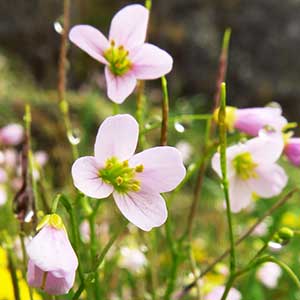Cardamine nymanii
Cardamine pattersonii
cuckoo bitter-cress, lady smock, northern field bitter-cress
Saddle Mountain bitter-cress
absent.
cylindrical, slender, 0.5–1.5 mm diam.
erect, unbranched or, rarely, branched, 0.5–1.6(–3.5) dm.
(simple from base), erect, (not flexuous), unbranched or branched basally, 0.6–3 dm.
(7 or) 9–21-foliolate, (thick, veins impressed);
leaflets petiolulate or sessile;
lateral lobes or leaflets similar to terminal;
terminal lobe or leaflet blade orbicular, broadly ovate to lanceolate, base rounded to cuneate, margins usually entire.
rosulate or not, 3 or 5-foliolate, 1–6 cm, leaflets petiolulate;
petiole 0.4–2.5 cm;
lateral leaflets similar to terminal, considerably smaller;
terminal leaflet (petiolule 0.1–0.4 cm), blade obovate to orbicular or subcordate, 0.3–1.5(–2.0) cm × 2.5–16(–18) mm, base obtuse to rounded or cordate, margins entire or dentate to slightly sinuately lobed.
2–4(–7), pinnatisect or pinnately compound, (7 or) 9–21-foliolate, (thick, veins impressed), petiolate, leaflets petiolulate or sessile;
petiole base not auriculate;
lobes or leaflets (of proximal leaves) (4–)7–10 each side of rachis, fewer distally, distal leaves with 4 or 5 lobes or leaflets each side of rachis;
terminal leaflet petiolulate or sessile, blade (or lobe) narrowly lanceolate to lanceolate, base cuneate, margins entire.
2–4, 3 or 5-foliolate, blade similar to basal, gradually reduced in size as bract, distalmost ones subtending pedicels of flowers (usually simple);
leaflet blade or bract linear to linear-oblanceolate, 0.2–0.8 cm.
ebracteate.
bracteate throughout.
sepals oblong or ovate, 3.6–4.4 mm, lateral pair saccate basally, (green with hyaline margins);
petals white-lilac, 9–12.3 × 4.8–6.8 mm, (clawed, apex rounded or emarginate);
filaments: median pairs 3.5–4.5 mm, lateral pair 2–3 mm;
anthers narrowly oblong, 0.9–1.4 mm.
sepals oblong, (2–)3 × 0.7(–1) mm, lateral pair not saccate basally;
petals purple or pink, obovate, 6–9 × 3–4 mm, (not clawed);
filaments: median pairs 3–3.5 mm, lateral pair 2–2.5 mm;
anthers oblong, 0.7–1 mm.
erect-ascending, 5–15 mm.
divaricate-ascending, (10–)15–30(–45) mm.
linear, 1–1.8 cm × ca. 1.5 mm;
ovules ca. 16 per ovary;
style ca. 1 mm, (stout).
linear, (torulose), 2–3 cm × 1–1.5 mm;
ovules 14–20 per ovary;
style 2–4 mm.
brown, oblong, ca. 1.5 mm.
brown, oblong to ovoid, 1.7–2.2 × 1–1.5 mm, (winged distally).
= 56, 60, 64, 80–100.
Cardamine nymanii
Cardamine pattersonii
Of conservation concern.
Cardamine pattersonii is known from Saddle Mountain and Onion Peak in Clastop County.
(Discussion copyrighted by Flora of North America; reprinted with permission.)
